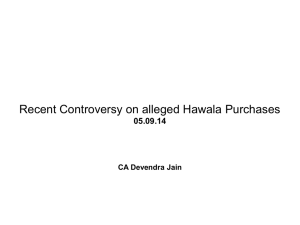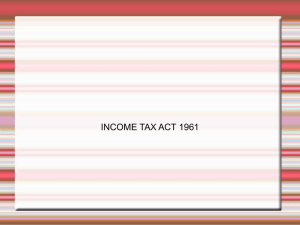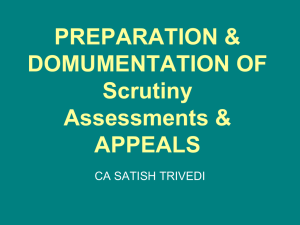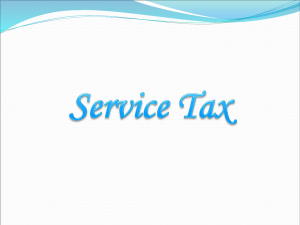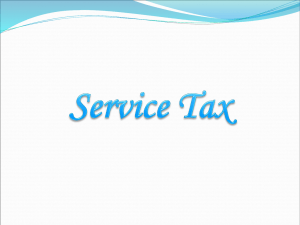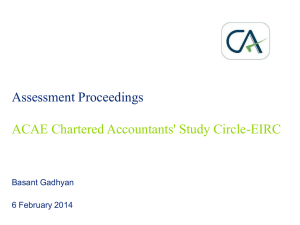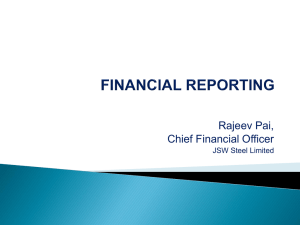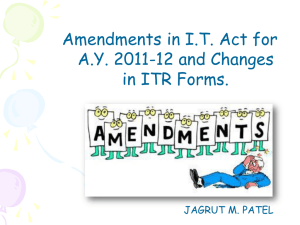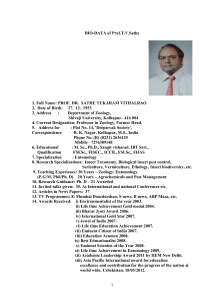Tax on Cash Credit, Unexplained Investments, etc 11th July 2012
advertisement
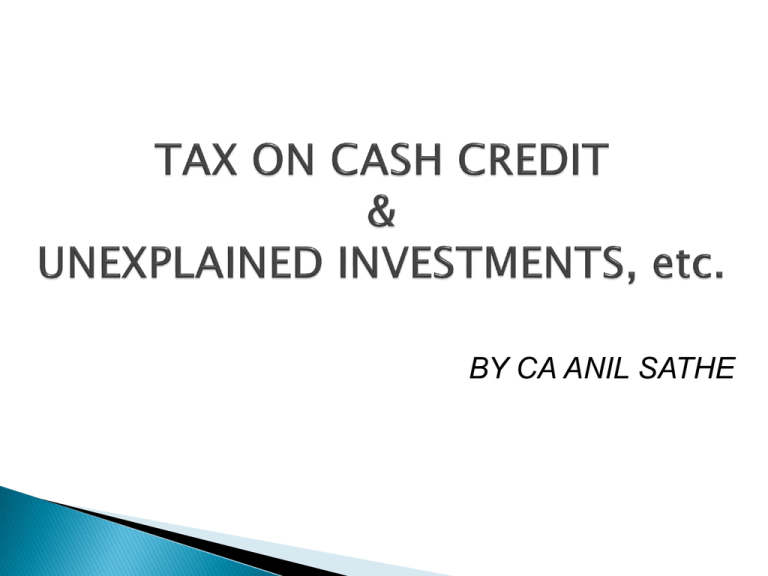
BY CA ANIL SATHE Introduced for the first time in Income Tax Act 1961 – there was no corresponding provision in Income Tax Act 1922 Purpose to tax unexplained credit entries – including moneys outstanding in capital accounts Receipt of share application money – initial onus on assessee to prove genuineness, creditworthiness and identity No satisfactory explanation – No automatic deeming fiction – addition depends upon discretion of AO & facts and circumstances of the case CIT vs. Smt. P. K. Noorjahan 237 ITR 570 (SC) CA ANIL SATHE Sum found credited in the books of the assessee assessee offers no explanation about the nature and source OR explanation offered by him is not satisfactory - in the opinion of the AO the sum so credited may be charged as the income of the assessee of that previous year Section 68 to 69D – known as “Rules of Evidence” CA ANIL SATHE Established position of law ◦ ◦ ◦ ◦ ◦ ◦ ◦ ◦ ◦ Sum credited in the books Books – maintained by assessee Assessee to offer prime facie proof/evidence of source Prima facie proof – qua assessee and qua quantum Degree of burden of proof to vary depending on the nature of credit and person from whom received Depends upon relation of assessee with creditor assessee not bound to establish “source of source” – onus restricted only to the extent of first source once assessee discharges initial burden the same to shift to the AO Also applicable to non-commercial loans and share application money CA ANIL SATHE Assessee should prove identity, capacity of lenders as well as genuineness of transaction Where lender is assessed to tax, assessee can avoid addition by filing confirmation with particulars of PAN Precautions to be taken while furnishing confirmation of unsecured loans: ◦ Mode of payment – Cash/DD/ Cheque ◦ Particulars of Bank, if available ◦ Whether interest-bearing loan ◦ Immediate source – If possible CA ANIL SATHE Independent evidence adduced by revenue calling for information u/s 133(6) or issuing summons u/s 131 Mandatory that the assessee is confronted with the said evidence and an opportunity of cross – examination afforded However cross-examination to be conducted within a reasonable time by assessee Failure to avail of opportunity may prove counter productive CA ANIL SATHE Affidavit is only an assertion by the lender and needs to be corroborated by independent additional evidence Such evidence may be documentary or oral by way of examination of the deponent CA ANIL SATHE Credit in the account of partner of firm admitted by the partner Credit in the books on the first day of the previous year where the assessee is a firm or company and business has not commenced Sale of jewellery declared under VDIS Amounts received through gifts from residents or non residents Amounts received through wills CA ANIL SATHE Suspicion however great cannot take the place of evidence Burden to prove apparent is not real lies on the revenue Addition cannot be made merely on the basis of conjectures and surmises Theory of human probabilities and surrounding circumstances is to be applied where there is no evidence or the evidence is insufficient CA ANIL SATHE Initial burden on assessee to explain “nature & source” of credit Prove identity of shareholder – by way of physical presence, registered address, PAN, etc. Prove Genuineness – Confirmation letter, bank statements, shareholder register, share application form, share transfer register, etc. Prove Creditworthiness – Creditor’s IT return, Balance Sheet – Profit & loss A/c CA ANIL SATHE Initial burden being discharged, onus on the Department to enquire and investigate about the creditworthiness & veracity of transaction – before making addition u/s 68 AO duty bound to prove that such addition on account of share application money or share capital – indeed income of the assessee No addition u/s 68 – merely because creditor fails to respond to Department notices Assessee’s AO cannot question creditor’s IT return or himself examine the Profit & Loss A/c – unless the return has been rejected by creditor’s AO CA ANIL SATHE CIT vs. Lovely Exports (P) Ltd. 216 CTR 195 (SC) CIT vs. Oasis Hospitalities Pvt.Ltd.333 ITR 119 (Del) CIT vs. Divine Leasing & Finance Ltd. 158 Taxman 440 (Del) CIT vs. Value Capital Services P. Ltd. 307 ITR 334 (Del) CIT Vs. Dataware Pvt. Ltd. (Cal HC) 15 Taxmann.com 225 (Del) 15 Taxmann.com 183 (Bom) 15 Taxmann.com 226 (Kar) CA ANIL SATHE Where the assessee is company (in which public are not substantially interested) ◦ Sum credited consists of share application money, share capital, share premium ◦ or any such amount by whatever name called ◦ any explanation offered by such assessee company shall be deemed to be not satisfactory Unless◦ the person, being resident in whose name such credit is recorded ◦ also offers an explanation about the nature and source of the sum credited and ◦ such explanation in the opinion of the assessing officer is found to be satisfactory Exclusion ◦ in regard to sum received from person who is a VCF or a VCC CA ANIL SATHE Total change from established position of law Complete deeming fiction to treat initial explanation by assessee company to be unsatisfactory The further explanation can be offered only by a resident person Non-resident not entitled to offer any explanation No mechanism to require AO to enforce co-operation from creditor CA ANIL SATHE Explanation to be offered by resident person – distinct views o Whether proviso is applicable only to residents and no explanation required to be offered by non-resident OR o That any explanation offered by non-resident deemed to be not satisfactory OR o Confirmation and Identity proof required – as per existing provision – would satisfy the AO The person offers an explanation – whether physical appearance or through written communication directly addressed to assessee’s AO required CA ANIL SATHE Where in the financial year immediately preceding the assessment year the assessee has made investments which are not recorded in the books of account and the assessee offers no explanation about the nature and source of the investments or the explanation offered by him is not satisfactory in the opinion of the assessing officer the value of investments may be deemed to be income of the assessee for the financial year CA ANIL SATHE where in any financial year the assessee is found to be the owner of any money, bullion, jewellery or other valuable article and such money bullion jewellery or valuable article or thing is not recorded in the books of account, if any maintained by the assessee and the assessee offers no explanation about the nature and source of acquisition or the explanation offered by him is in the opinion of the assessing officer not satisfactory then the money and the value of bullion jewellery or other valuable article may be deemed to be the income of the assessee for such financial year CA ANIL SATHE Where in any financial year Assessee has incurred any expenditure and he offers no explanation about the source of such expenditure or part thereof Or the explanation offered by him is not satisfactory in the opinion of AO the amount covered by such expenditure or part thereof may be deemed to be income of the assessee for such financial year CA ANIL SATHE Section 68 requires the assessee to explain credit in books of accounts Section 69 to 69 B require establishing of sources of investments, money, bullion jewellery or other valuable article , not recorded in books of account. In section 68 onus is only on assessee to explain the source of the entry In section 69 to 69B the revenue is to establish that the investment has been made by the assessee Or the assessee is found to be the owner of money bullion jewellery or any other valuable article In section 69 C it is essential to establish that the assessee has incurred the expenditure - before the provisions can be invoked CA ANIL SATHE Inflated stock to bank Investment by one person in the name of another person Understatement of purchase consideration Unexplained household expenditure Unaccounted marriage expenses Unverifiable purchases CA ANIL SATHE Where total income of an assessee includes income referred to in sections 68 to 69D ◦ amount of income taxable shall be aggregate of ◦ amount of income tax calculated on income referred to in 68 to 69D ◦ at the rate of 30% and ◦ the amount of income tax with which assessee would have been chargeable ◦ had his total income been reduced by the aforementioned sums ◦ No deduction in respect of any expenditure to be allowed ◦ in computing income referred to in 68 to 69D CA ANIL SATHE Issues Earlier section 68 – only a Rule of Evidence – general principle to charge as Income from Business or Income from Other Sources Now section 115BBE – Charging Section – tax income referred to in section 68 What is the character of income u/s 68 – whether Income from Business or Income from Other Sources – provision de horse of both heads of income Sec 115BBE – whether reference to character of income or quantum of income CA ANIL SATHE Whether provision applicable irrespective of slab rates or basic exemptions No deduction of expenses – but whether set-off of losses allowed Total income “includes” Income referred to in sec 68 – “Income” different concept than “sum to be treated as income” Whether Chapter VI-A deduction allowed – or income taxable under similar lines as winning from lottery, puzzles u/s 115BB CA ANIL SATHE
